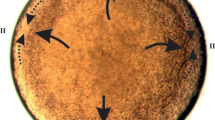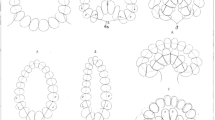Conclusions
An experimental study of the problem of gastrulation has yielded evidence which shows that the present prevailing theories are inadequate to account for the facts.
Especial attention has been given to the theory ofAssheton, according to which the geometrical relation of nuclei to the cells in the blastula is of fundamental importance to invagination. It was found that an excess of calcium added to the sea water in which the cultures ofS. purpuratus were raised caused a displacement of the nuclei to the inside so that they appeared at the edge of the blastocoele. Lithium larvae on the other hand showed the nuclei disposed toward the periphery in the cells of the blastulae. Since, however, nuclear position did not uniformly correspond to invagination or evagination as the case happened to be, the view that the position of the nuclei determines invagination had to be given up.
A modification ofAssheton's view is suggested, namely, that invagination is caused by cell bridges asymmetrically placed. The eccentric attraction between the cells at the vegetal pole therefore presumably depends upon physical structures and not, asAssheton supposed, upon an attraction between the nuclei.
Similar content being viewed by others
Literature cited
Rhumbler, L., Zur Mechanik des Grastrulationsvorganges. Arch. f. Entw.-Mechanik, Vol. 14, p. 401, 1902.
Bütschli, O., Bemerkungen zur mechanischen Erklärung der Gastrula-Invagination. Sitz.-Ber. Akad. Wissensch., Heidelberg, Vol. 4, 1915.
Spek, J., Quoted in T. H. Morgan's Experimental Embryology. New York, pp. 216 to 218, 1927.
Assheton, R., The geometrical relation of the nuclei in an invaginating gastrula. Cambridge, 1916.
Herbst, C., Exp. Untersuch, ü. d. Einflu\ d. veränd. chemischen Zusammensetzung d. umgebenden Mediums. Zeitschr. f. wiss. Zool., Vol. 55, 1895.
Roux, W., über den „Cytotropismus“ der Furchungszellen des Grasfrosches. Arch. f. Entw.-Mechanik, Vol. I, 1894.
Galtsoff, P. S., Regeneration after dissociation in sponges. Journ. Exp. Zool., Vol. 42, p. 183, 1925.
Moore, A. R., Fertilization and development without the fertilization membrane in the egg ofDendraster eccentricus. Protoplasma,This issue.
Assheton, R., The geometrical relation of the nuclei in an invaginating gastrula. Cambridge, 1916, p. 75.
Moore, A. R., On the hyaline membrane and hyaline droplets of the fertilized egg of the sea urchin. Protoplasma, Vol. 3, p. 524, 1928.
—, Self differentiation of the intestine in the larva of the sand urchin. Proc. Soc. Exp. Biol. and Med., Vol. 25, p. 40, 1927.
Author information
Authors and Affiliations
Additional information
I am glad to express my thanks to MissWinnefred Bradway and Mr. S. H.Whong for their assistance in preparing sections and making sketches, and to Mr.Henry Hill of the Yaquina Head Light House for his kindness and hospitality which made part of the work possible.
Aided by a grant from the research fund of the University of Oregon.
Rights and permissions
About this article
Cite this article
Moore, A.R. On the invagination of the gastrula. Protoplasma 9, 25–33 (1930). https://doi.org/10.1007/BF01943333
Received:
Published:
Issue Date:
DOI: https://doi.org/10.1007/BF01943333




